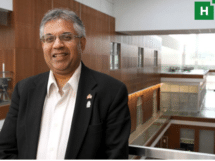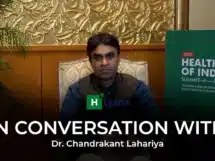Dr Sameer Kaul, one of India’s leading surgical oncologists, terms the lifestyle as a major contributor to cancer than genetic susceptibility.
The simple changes in lifestyle, he said, can considerably reduce the chances of contracting the deadly disease
In our conversation, Dr Kaul weighed in on the rising prevalence of the various types of malignancies in India, which he attributed to a variety of causes, including our food habits, genetic makeup, ageing, and the slowly encroaching effects of climate change.
“But lifestyle is the main thing,” Dr Kaul stressed. “Whether it’s our tobacco usage, alcohol consumption, the kind of food we eat, the social norms we follow in terms of the number of children we rear, the age at which we get married, the amount of time we give to our health, or the preventive strategies that we adopt from time to time.”
Excerpts from the interview:
What is the most common cancer found in India and why?
It’s different for the males and it’s different for the females. The commonest cancer in India will continue to be – and has been for a long time – is the lung cancer. It’s numbers are rising each year.
It used to be head and neck cancer for a long, long time. Which means the various parts of head and neck: the oral cavity, the pharynx, and the upper part of the food pipe. But now that cancer has slowly, slowly abated. It’s still a significant cancer in our country.
In women, the commonest cancer was cervical cancer. Now it has been taken over by the breast cancer. Whereas in the west, breast cancer has ebbed.
Cancer epidemiology changes over time, from from year to year, from decade to decade. And if you look at our cancer registry it records this shift. Lung, head and neck, cervical breast, GI, gastrointestinal cancers are considerable in number.
Our dietary habits have been found to be a trigger for some cancers. What is the one thing that you would people to avoid in their food to reduce their incidence?
Like the old saying goes, an ounce of prevention is worth a pound in cure. There are two levels of prevention: One is primary prevention, which means if this is a cancer producing environment, don’t go there at all. It’s called primary prevention.
But the problem is we can’t entirely live without being in that environment. For example, living the life that we currently live, where we wear the clothes which have the coloring agents, eat the food which has the preservatives and many other things that we can’t control.There are cancer producing substances in our diet, in the air and in our external environment.
Which state or region in India has the most food-related cancers?
Food is again a lifestyle choice. Towards the north of this country, for example in Jammu and Kashmir, and down South, a lot of GI cancers are reported. Spicy is the way they cook it. A lot red meat is consumed. But the highest number of stomach cancer are in Mizoram because, again, linked to the kind of food they eat. They eat a lot of non-vegetarian food that is roasted over the fire and coated with carbonaceous deposits that create an ideal environment for cancer to develop.
Not only in this country, if you look towards your neighbors, Afghanistan, northern tip of Iran, the northern tip of China, you will find a lot of food related cancers. And food is again a lifestyle choice.
It is also so with alcohol consumption and smoking. Some of the hilly mountainous areas in India seea lot of alcoholic consumption as well. The people in these places also have a lot of masala food. This leads to gastritis and erosions inside your gastrointestinal tract. So a lot of acid peptic dyspepsia and Barrett’s esophagus get created there, and that’s why you have higher incidence of GI cancer.
If the diet is exclusively red meat, if it’s not balanced with lean meat, veggies, fruits, it’s problematic. The way you prepare red meat, if you use a lot of spices, a lot of the polycyclic hydrocarbons and aromatic amines are produced in our body. It also triggers nitrates, nitrites and super radicals.
Pickling is again problematic because if you use pickled meats, they are dangerous and are responsible for creating stomach cancers.
There is external environment and the internal environment. Food becomes an internal environment. And if there is a genetic message as well, you get unlucky. All of all of them combine together to do the bad job.
Climate change has affected people’s health all over the world. Are there any new forms of cancer that have resulted because of this?
Climate change over a period of time over healthcare and cancer production is not so evident. But what is definitely evident is the demographic change, the life expectancy that has gone up everywhere and also in our part of the world. People in our part of the world used to die young. Not anymore. So we have a higher incidence of cancers of old age such as prostate, esophagus or ovaries.
We were escaping them because we wouldn’t live long enough. The longer we live, the more cancer patients we have.
Can a healthy lifestyle prevent cancer, or certain types of it?
Lifestyle is one of the most major reasons for cancer production. The other is genetics, the genetic message that you are carrying inside of you. But lifestyle is the main thing: Whether it’s our tobacco usage, alcohol consumption, the kind of food we eat, the social norms we follow in terms of the number of children we rear, the age at which we get married, the amount of time we give to our health, or the preventive strategies that we adopt from time to time. Like, do we go for checkups and all those things. Stress has been a new factor.
So lifestyle is a major, major challenge in terms of cancer production and prevention. At least 70 percent of it occurs through lifestyle and it can be prevented by a simple change in lifestyle.
How can families with a hereditary susceptibility to cancer safeguard against the disease?
We’ve you just woken up to this hereditary business. And it is so true that we know now that about 10 to 15 percent of cancers are hereditary. And there are all kinds of variations on that. There are genes that you inherit that have a dominant representative character in the next generation.There are regressive ones also, which means a light influence.
So your risk of developing and transmitting cancer to your progeny are proportional to the strength in the inherited gene. We are aware of it and we factor it into our treatment to find out whether a cancer case that comes to us is a sporadic occurrence. Most often, it is. 85 percent are still sporadic. But if it’s hereditary, then you have to look at it differently. And we know now because there are tests available to confirm it.
There are biomarkers for hereditary cancers like the Lynch syndrome, for polyps in the colon, the thyroid cancers or the breast cancer. There is clear cut genetic preponderance that runs in families.
And there are cancer family syndromes of so many kinds. There is now a very important subject in oncology called Oncology, where a geneticist will sit with our team and guide a patient family, that has got this gene: the BRCA1 and BRCA2 gene we all know about. Now we are finding more BRCAs in our society. We didn’t even look for them earlier. Now even a simple ₹13,000 worth of blood test at a private clinic can tell you whether you inherited a gene. Because these are very high penetrance genes, they carry 85 to 90 percent risk of developing that particular cancer. And we look at it in our biopsy reports and we look at it in the blood. We find out the mutations.
Blood biopsy, by the way, is the new thing: just getting a blood sample to tell you whether you stand a chance of inheriting a cancer. And if you do, what are your chances and what kind of a cancer will it be? It’s all happening. The human genome is being mapped at a furious rate, and I can tell you very soon we’re going to have a human compendium. You’ll have a genetic history, you’ll have a DNA history, you’ll have everything.
What are the latest technological advancements in cancer treatment in India?
Possibly whatever has happened elsewhere has come to India. It always comes to India quite fast for two reasons.
Sometimes – I also joke about this – it comes so fast, because our monitoring and regulatory authorities are quicker to approve the new treatment Convincing a regulatory authority in Europe takes longer than it does here. But the good thing is that the newer changes come into India first. So the first part of your question is answered.
Molecular diagnosis is a reality. Now we look at your molecular nature of the tumor and we try to even find out what drugs will most likely work in this particular cancer, in this particular individual. So bespoke diagnosis, not off the shelf,, because no individual, no disease is the same as the other one.
It may be the same stage, it may be the same disease, but it will behave differently because there are so many things that go into what happens with the disease and its life history. So today with a blood sample we can find out those things for which we needed a tissue earlier..
So mutations are being mapped and those mutations are being attacked by drugs which are coming at such a furious rate. There are now oral tablets called tyrosine kinase inhibitors for lung cancer, for ovarian cancer, for all kinds of cancers. Now, with each year we are adding new drugs. .
Sometimes I wonder my poor brain, how would it handle the whole thing but I don’t have an option. So you’ve got to be updated becauseUnited States Food and Drug Administration clears these drugs on the double. They do it because so much research is happening. It’s become easier to do research because of digital, artificial intelligence. Things happen faster across continents. New drugs are coming in and attacking these new mutations: the fibroblast growth factor, the vascular endothelial growth factor. So there are new drugs, your armory has got now smart guns. There is now now targeted bombing for these illnesses. And immunotherapy, that just uses the body’s own immune system to fight the cancer and defeat it.And, you know, CAR-T cell therapy. These have become possibilities for our patients here and they’re already in operation.
Similarly for delivery of radiation, the proton beam, tomo therapy, these are newer and better machines which deliver accurate radiation to kill the cancer without causing a scatter. We get better results and lesser side effects. .
So molecular diagnosis, targeted therapies, bespoke oncology, where I can tailor my treatment to your disease and even monitor what’s happening with you through your blood samples by looking at circulating DNA. This is fascinating stuff. We have new drugs, but they are expensive.
The link to the video is here.
Read More: https://h-leads.com/public-health-should-take-precedence-over-curative-medicine/


















Add Comment